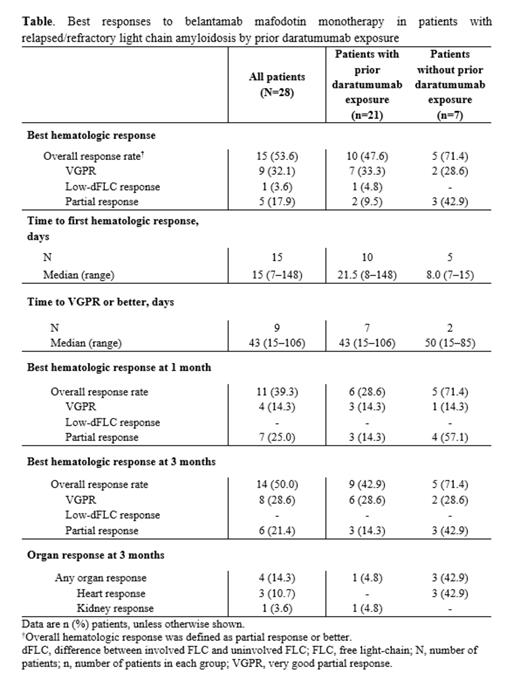Introduction
Belantamab mafodotin (belamaf) targets B-cell maturation antigen (BCMA) expressing plasma cells (PCs) and is approved for heavily pretreated patients (pts) with relapsed/refractory (RR) multiple myeloma. Clonal PCs in light-chain (AL) amyloidosis also express BCMA; thus, belamaf could be a treatment option for RRAL amyloidosis pts. We present an interim analysis of the prospective EMN27 study assessing efficacy and safety of belamaf monotherapy in RRAL amyloidosis pts.
Methods
The ongoing prospective, open-label, multinational, phase 2 EMN27 study (NCT04617925) aims to enroll 36 adult pts with RR (defined as ≥2 cycles of therapy directed against PC clone) AL amyloidosis, adequate hematologic, hepatic, renal, and cardiac function, and ECOG ≤2. Pts at Mayo cardiac stage 3B or with previous exposure to anti-BCMA agents are excluded. Monotherapy with belamaf at a starting dose of 2.5 mg/kg (or 1.92 mg/kg for toxicity) is administered by intravenous infusion every 6 weeks for up to 8 cycles. Pre-planned study analyses included an interim safety (after first 6 pts received ≥1 treatment cycle) and an efficacy analysis (after 13 pts were enrolled). Outcomes of both were favorable and study enrollment is ongoing. This descriptive analysis included pts initiating treatment ≥3 months before 31/05/2023 (cutoff date).
Results
Twenty-eight pts have been included in this analysis (median [range] age: 66 years [46-80]; male: 16 [57%]). At screening, 5 (18%), 15 (54%), and 8 (29%) pts were rated as Mayo stages I, II, and IIIA, respectively. Most pts had cardiac involvement (22, 79%), followed by those with renal (17, 61%) and peripheral nerve (6, 21%) involvement. Most pts (21, 75%) had New York Heart Association class II symptoms and the median N-terminal pro-brain natriuretic peptide, high-sensitivity troponin T, and difference in involved and uninvolved free light chain (dFLC) were 1,393 ng/L (90-7,270), 34 ng/L (3-116), and 119 mg/L (38-2,791), respectively.
The median number of prior treatment lines was 4 (1-10). Twenty-one (75%) pts had previously received daratumumab (dara) (12 [42.9%] dara refractory pts), while 24 (86%) pts had previously received bortezomib, both with median of 4 (1-10) prior treatment lines. At cutoff, 4 (14%) pts were continuing therapy, 21 (75%) pts discontinued (disease progression/inadequate response: 9 [32%]; adverse events [AE]: 8 [29%]; withdrew consent: 1 [4%]; death 3 [11%]), and 3 (11%) pts completed treatment. Median belamaf cycles administered were 3 (1-8). Ninety-five belamaf doses were given (2.5 mg/kg: 72, 1.92 mg/kg: 23). Eleven (39%) pts had 23 belamaf dose holds due to AE/SAE, with median delay of 21 (7-128) days from planned administration.
At a median follow up of 16 months (4-26), the overall hematologic response (≥partial response [PR]) and very good partial response (VGPR) rates were 54% (15 pts) and 32% (9 pts), respectively ( Table). Median times to first hematologic response and VGPR were 15 (7-148) and 43 (15-106) days, respectively ( Table). Median duration of hematologic response (time from first response to hematologic progression or treatment/disease-related death) was not reached either for all pts or for pts pre-treated with dara. At 1 and 3 months, the respective overall hematologic responses were 39% (11 pts) and 50% (14 pts). Respective rates for pts with prior dara exposure were 29% (6 pts) and 43% (9 pts). For all pts, 3-month organ response rate was 14% (4 pts; Table).
All pts experienced >1 AE (ocular AEs: 27 [96%] pts; hematologic toxicity: 8 [30%] pts; cardiac disorders: 7 [25%] pts); no new cardiac or renal toxicity observed. Three (11%) pts had a fatal AE, all considered unrelated to belamaf. Twenty-two (79%) pts had visual acuity reduced (grade [Gr]1: 3 (11%); Gr2: 8 [29%]; Gr3: 10 [36%]; Gr4: 1 [4%]), 22 (79%) keratopathy (Gr1: 10 [36%]; Gr2: 8 [29%]; Gr3: 4 [14%]; Gr4: 0 [0%]), and 7 (25%) visual impairment (Gr1: 1 [4%]; Gr2: 4 [14%]; Gr3: 1 [4%]; Gr4: 1 [4%]).
Conclusions
In heavily pretreated pts with RRAL and limited treatment options, belamaf monotherapy achieved an overall hematologic response of 54% without unexpected toxicity. Results suggest belamaf could be a treatment option for RRAL amyloidosis, a difficult to treat population. Further evaluation of belamaf in combination with other active agents could allow longer intervals (i.e., 8-12 weeks) between belamaf doses, which has shown to reduce ocular toxicity, while maintaining efficacy.
Disclosures
Kastritis:Janssen: Honoraria, Research Funding; GSK: Honoraria, Research Funding; Pfizer: Honoraria, Research Funding; Sanofi: Honoraria. Palladini:Sebia: Honoraria; Prothena: Consultancy, Honoraria; Pfizer: Honoraria; Janssen: Consultancy, Honoraria, Membership on an entity's Board of Directors or advisory committees; Argobio, GSK: Consultancy; Siemens: Honoraria. Minnema:UMC Utrecht Cancer Center: Current Employment; Beigene: Research Funding, Speakers Bureau; CDR life: Consultancy; GSK: Consultancy; Janssen Cilag: Consultancy, Honoraria, Speakers Bureau. Wechalekar:Attralus: Honoraria; Alexion: Honoraria; GSK: Honoraria; Janssen: Honoraria; Takeda: Other: Travel support; Alexion, Attralus, Janssen, Prothena.: Consultancy. Papachristou:Health Data Specialists: Current Employment. Psarros:Health Data Specialists: Current Employment. Sonneveld:Pfizer: Membership on an entity's Board of Directors or advisory committees; Karyopharm: Membership on an entity's Board of Directors or advisory committees, Research Funding; Janssen: Membership on an entity's Board of Directors or advisory committees, Research Funding; Celgene: Membership on an entity's Board of Directors or advisory committees, Research Funding; Bristol Myers Squibb: Membership on an entity's Board of Directors or advisory committees, Research Funding; Amgen: Membership on an entity's Board of Directors or advisory committees, Research Funding.


This feature is available to Subscribers Only
Sign In or Create an Account Close Modal